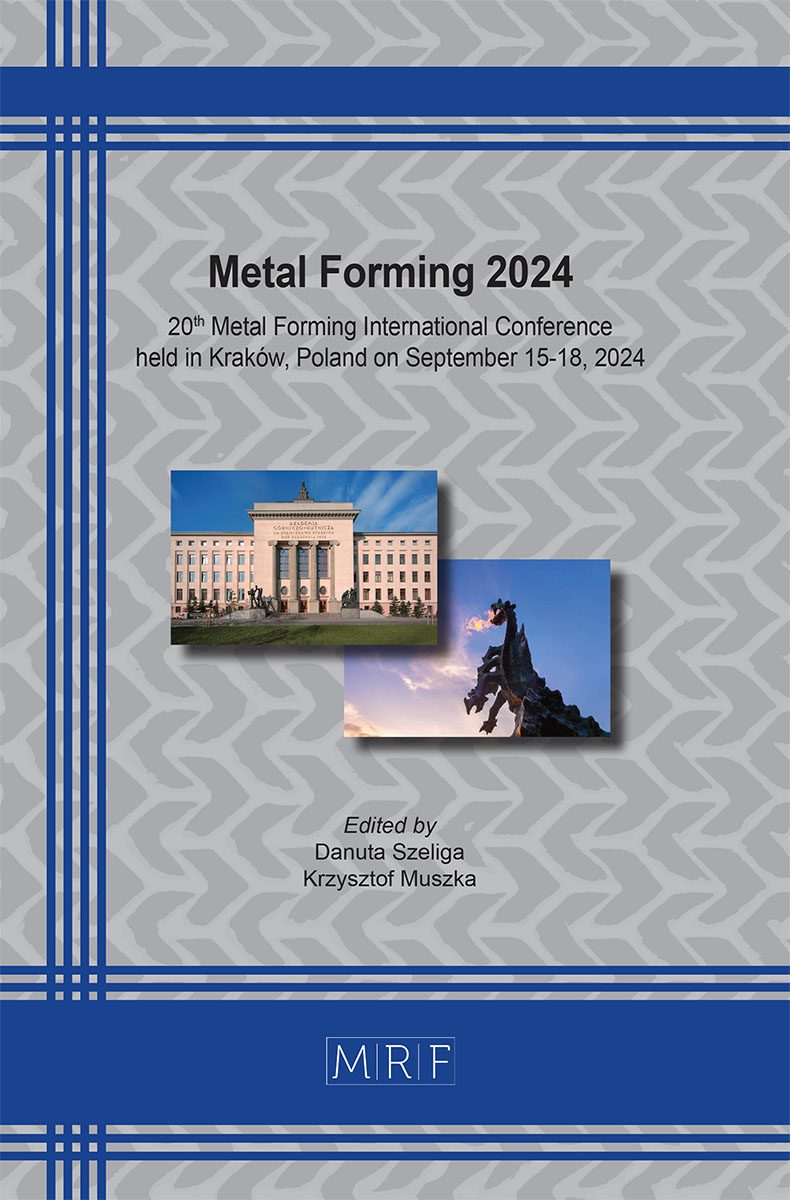–
Hemming for improvement of joint strength in aluminium alloy and carbon fibre-reinforced thermoplastic sheets
ABE Yohei, KIMURA Kensuke
download PDFAbstract. To increase the joint strength in hemmed aluminium alloy and carbon fibre-reinforced thermoplastic (CFRTP) sheets, two kinds of hemming processes were proposed. In a hemming process, hemming was combined with protrusions with structures on the surface on the aluminium alloy sheet. The protrusions with structure were firmly joined to the surface on the sheet by laser cladding with fine ceramic powders, and then the heated and softened CFRTP sheet material was compressed and infiltrating into the protrusions in hot pressing. In the other hemming process, hemming was combined with the aluminium alloy sheet with drilled holes. The heated and softened CFRTP was flowed into the holes in hot pressing. Each hot press condition was investigated. And then, the strength in the pull-out direction and the strength in the peel direction were measured and compared. The joint strengths by the proposed two hemming processes were larger than that by hemming only.
Keywords
Metal/Polymer, Joining, Hemming, Carbon Fibre-Reinforced Thermoplastic, Hot Pressing, Aluminium Alloy Sheet
Published online 9/15/2024, 10 pages
Copyright © 2024 by the author(s)
Published under license by Materials Research Forum LLC., Millersville PA, USA
Citation: ABE Yohei, KIMURA Kensuke, Hemming for improvement of joint strength in aluminium alloy and carbon fibre-reinforced thermoplastic sheets, Materials Research Proceedings, Vol. 44, pp 698-707, 2024
DOI: https://doi.org/10.21741/9781644903254-75
The article was published as article 75 of the book Metal Forming 2024
![]() Content from this work may be used under the terms of the Creative Commons Attribution 3.0 license. Any further distribution of this work must maintain attribution to the author(s) and the title of the work, journal citation and DOI.
Content from this work may be used under the terms of the Creative Commons Attribution 3.0 license. Any further distribution of this work must maintain attribution to the author(s) and the title of the work, journal citation and DOI.
References
[1] M. Pouranvari, S.P.H. Marashi, Critical review of automotive steels spot welding: Process, structure and properties, Sci. Tech. Weld. Join. 18-5 (2013) 361 – 403. https://doi.org/10.1179/1362171813Y.0000000120
[2] D. Li, A. Chrysanthou, I. Patel, G. Williams, Self-piercing riveting-a review, Int. J. Adv. Manuf. Tech. 92-5-8 (2017) 1777 – 1824. https://doi.org/10.1007/s00170-017-0156-x
[3] T. Sakiyama, Y. Naito, Y. Miyazaki, T. Nose, G. Murayama, K. Saita, H. Oikawa, Dissimilar metal joining technologies for steel sheet and aluminum alloy sheet in auto body, Nippon Steel Technical Report 103 (2013) 91 – 98. https://www.scopus.com/inward/record.uri?eid=2-s2.0-84879387161&partnerID=40&md5=82c16e8027334a80781738cc86d97690
[4] J.M. Arenas, C. Alía, J.J. Narbón, R. Ocaña, C. González, Considerations for the industrial application of structural adhesive joints in the aluminium–composite material bonding, Compos. Part B: Engineering 44 (2013) 417–423. https://doi.org/10.1016/j.compositesb.2012.04.026
[5] G. Di Franco, L. Fratini, A. Pasta, V. Ruisi, On the self-piercing riveting of Al blanks and carbon fiber composite panels, Int. J. Mater. Forming 31 (2010) 1035–1038. https://doi.org/10.1007/s12289-011-1067-2
[6] F. Lambiase, D.C. Ko, Feasibility of mechanical clinching for joining aluminum AA6082-T6 and carbon fiber reinforced polymer sheets, Mater. Design 107 (2016) 341–352. https://doi.org/10.1016/j.matdes.2016.06.061
[7] C.J. Lee, J.M. Lee, H.Y. Ryu, K.H. Lee, B.M. Kim, D.C. Ko, Design of hole-clinching process for joining of dissimilar materials – Al6061-T4 alloy with DP780 steel, hot-pressed 22MnB5 steel, and carbon fiber reinforced plastic, J. Mater. Process. Tech. 214–10 (2014) 2169–2178. https://doi.org/10.1016/j.jmatprotec.2014.03.032
[8] K. Nagatsuka, S. Yoshida, A. Tsuchiya, K. Nakata, Direct joining of carbon-fiber–reinforced plastic to an aluminum alloy using friction lap joining, Compos. Part B: Engineering 73 (2015) 82–88. https://doi.org/10.1016/j.compositesb.2014.12.029
[9] S.M. Goushegir, J.F. dos Santos, S.T. Amancio-Filho, Friction Spot Joining of aluminum AA2024/carbon-fiber reinforced poly (phenylene sulfide) composite single lap joints: Microstructure and mechanical performance, Mater. Design 54 (2014) 196–206. https://doi.org/10.1016/j.matdes.2013.08.034
[10] S. Kalpakjian, S. Schmid, Manufacturing Engineering & Technology, 7th ed.; Pearson Education South Asia Pte Ltd.: Singapore (2013) 410.
[11] W. Woyke, F. Jesche, S. Menzel, D. Landgrebe, Designing a flawless hem flange bonding process. adhesion ADHESIVES + SEALANTS, 14 (2017) 26–29. https://doi.org/10.1007/s35784-017-0020-2
[12] T. Maeda, Direct joining technology for metal and plastics by positive anchor effort, Journal of the Japan Society for Precision Engineering 84–5 (2018) 419–422 (in Japanese). https://doi.org/10.2493/jjspe.84.419
[13] K. Iwata, A. Suzuki, S.G. Kim, N. Takata, M. Kobashi, Enhancing the solid-state joinability of A5052 and CFRTP via an additively manufactured micro-structure, J. Mater. Process. Tech. 306 (2022) 117629. https://doi.org/10.1016/j.jmatprotec.2022.117629
[14] Z. Hamedon, K. Mori, Y. Abe, Hemming for joining high strength steel sheets, Procedia Eng. 81 (2014) 2074–2079. https://doi.org/10.1016/j.proeng.2014.10.288












